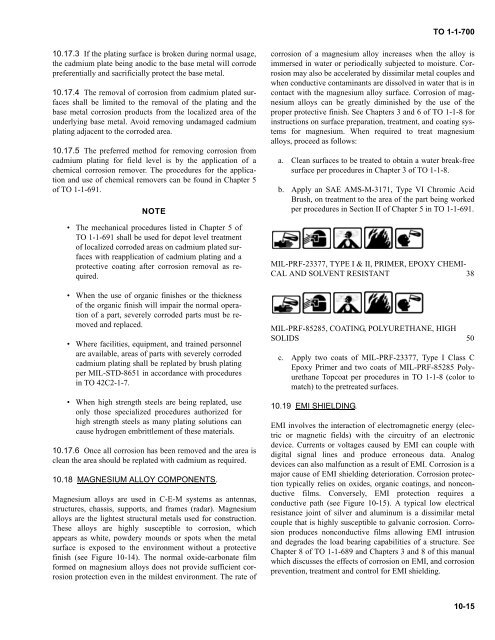TO 1-1-700 - Robins Air Force Base
TO 1-1-700 - Robins Air Force Base
TO 1-1-700 - Robins Air Force Base
Create successful ePaper yourself
Turn your PDF publications into a flip-book with our unique Google optimized e-Paper software.
<strong>TO</strong> 1-1-<strong>700</strong><br />
10.17.3 If the plating surface is broken during normal usage,<br />
the cadmium plate being anodic to the base metal will corrode<br />
preferentially and sacrificially protect the base metal.<br />
10.17.4 The removal of corrosion from cadmium plated surfaces<br />
shall be limited to the removal of the plating and the<br />
base metal corrosion products from the localized area of the<br />
underlying base metal. Avoid removing undamaged cadmium<br />
plating adjacent to the corroded area.<br />
10.17.5 The preferred method for removing corrosion from<br />
cadmium plating for field level is by the application of a<br />
chemical corrosion remover. The procedures for the application<br />
and use of chemical removers can be found in Chapter 5<br />
of <strong>TO</strong> 1-1-691.<br />
NOTE<br />
• The mechanical procedures listed in Chapter 5 of<br />
<strong>TO</strong> 1-1-691 shall be used for depot level treatment<br />
of localized corroded areas on cadmium plated surfaces<br />
with reapplication of cadmium plating and a<br />
protective coating after corrosion removal as required.<br />
• When the use of organic finishes or the thickness<br />
of the organic finish will impair the normal operation<br />
of a part, severely corroded parts must be removed<br />
and replaced.<br />
• Where facilities, equipment, and trained personnel<br />
are available, areas of parts with severely corroded<br />
cadmium plating shall be replated by brush plating<br />
per MIL-STD-8651 in accordance with procedures<br />
in <strong>TO</strong> 42C2-1-7.<br />
• When high strength steels are being replated, use<br />
only those specialized procedures authorized for<br />
high strength steels as many plating solutions can<br />
cause hydrogen embrittlement of these materials.<br />
10.17.6 Once all corrosion has been removed and the area is<br />
clean the area should be replated with cadmium as required.<br />
10.18 MAGNESIUM ALLOY COMPONENTS.<br />
Magnesium alloys are used in C-E-M systems as antennas,<br />
structures, chassis, supports, and frames (radar). Magnesium<br />
alloys are the lightest structural metals used for construction.<br />
These alloys are highly susceptible to corrosion, which<br />
appears as white, powdery mounds or spots when the metal<br />
surface is exposed to the environment without a protective<br />
finish (see Figure 10-14). The normal oxide-carbonate film<br />
formed on magnesium alloys does not provide sufficient corrosion<br />
protection even in the mildest environment. The rate of<br />
corrosion of a magnesium alloy increases when the alloy is<br />
immersed in water or periodically subjected to moisture. Corrosion<br />
may also be accelerated by dissimilar metal couples and<br />
when conductive contaminants are dissolved in water that is in<br />
contact with the magnesium alloy surface. Corrosion of magnesium<br />
alloys can be greatly diminished by the use of the<br />
proper protective finish. See Chapters 3 and 6 of <strong>TO</strong> 1-1-8 for<br />
instructions on surface preparation, treatment, and coating systems<br />
for magnesium. When required to treat magnesium<br />
alloys, proceed as follows:<br />
a. Clean surfaces to be treated to obtain a water break-free<br />
surface per procedures in Chapter 3 of <strong>TO</strong> 1-1-8.<br />
b. Apply an SAE AMS-M-3171, Type VI Chromic Acid<br />
Brush, on treatment to the area of the part being worked<br />
per procedures in Section II of Chapter 5 in <strong>TO</strong> 1-1-691.<br />
MIL-PRF-23377, TYPE I & II, PRIMER, EPOXY CHEMI-<br />
CAL AND SOLVENT RESISTANT 38<br />
MIL-PRF-85285, COATING, POLYURETHANE, HIGH<br />
SOLIDS 50<br />
c. Apply two coats of MIL-PRF-23377, Type I Class C<br />
Epoxy Primer and two coats of MIL-PRF-85285 Polyurethane<br />
Topcoat per procedures in <strong>TO</strong> 1-1-8 (color to<br />
match) to the pretreated surfaces.<br />
10.19 EMI SHIELDING.<br />
EMI involves the interaction of electromagnetic energy (electric<br />
or magnetic fields) with the circuitry of an electronic<br />
device. Currents or voltages caused by EMI can couple with<br />
digital signal lines and produce erroneous data. Analog<br />
devices can also malfunction as a result of EMI. Corrosion is a<br />
major cause of EMI shielding deterioration. Corrosion protection<br />
typically relies on oxides, organic coatings, and nonconductive<br />
films. Conversely, EMI protection requires a<br />
conductive path (see Figure 10-15). A typical low electrical<br />
resistance joint of silver and aluminum is a dissimilar metal<br />
couple that is highly susceptible to galvanic corrosion. Corrosion<br />
produces nonconductive films allowing EMI intrusion<br />
and degrades the load bearing capabilities of a structure. See<br />
Chapter 8 of <strong>TO</strong> 1-1-689 and Chapters 3 and 8 of this manual<br />
which discusses the effects of corrosion on EMI, and corrosion<br />
prevention, treatment and control for EMI shielding.<br />
10-15
















